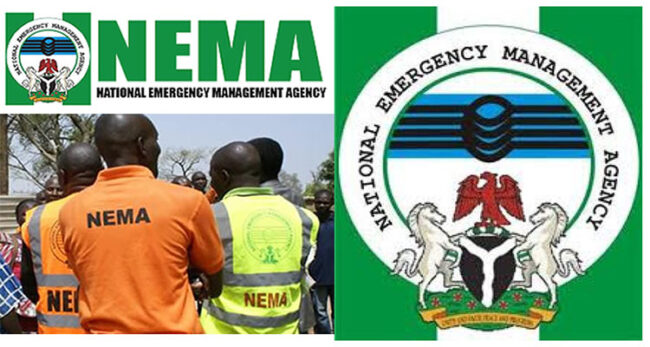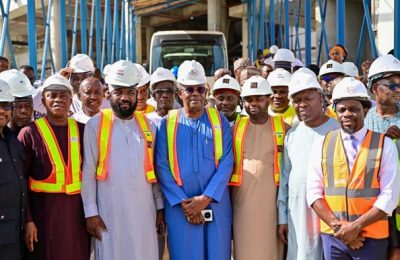Experts from the National Emergency Management Agency (NEMA) and other stakeholders have emphasized the urgent need to develop and adopt the National Disaster Risk Reduction Strategy and Action Plan 2023-2030 to protect over 200 million Nigerians who are highly vulnerable to disaster risks.
Speaking in Abuja during the flag-off of a three-day ‘Expert Workshop on Early Warning for All, National Disaster Risk Reduction Strategy and Action Plan 2023-2030’ on Monday, NEMA Director General Mrs. Zubgaida Umar noted that the workshop coincides with the ongoing flood season in Nigeria.
This timing, she said, offers an opportunity to review the country’s preparedness, response, mitigation, and long-term recovery strategies.

Mrs. Umar explained that the need for this Plan arose from findings of an assessment conducted by the Overseas Development Institute on behalf of the United Nations Development Program (UNDP).
According to her, the “assessment was conducted to evaluate the status of Disaster Risk Reduction (DRR) and the implementation of the Sendai Framework for DRR 2015-2030 in seven selected countries in the Sahel region, including Nigeria, Burkina Faso, Chad, Mali, Mauritania, Niger, and Senegal.
ALSO READ: Edo women demand Oshiomhole’s apology over comment on Betsy Obaseki
“A review of NEMA’s existing plans and frameworks indicated an urgent need for a more comprehensive action plan for disaster risk management in Nigeria, considering new and emerging hazards in the country.

This plan should align with the Sendai Framework and the African Program of Action (PoA) to enhance disaster resilience and drive sustainable development.
It is on record that the current escalation of disaster events, including conflicts, banditry, and annual floods, coupled with extreme weather events, has created a compelling need to develop the DRR Strategy and Action Plan for Nigeria.
Today’s workshop is part of the Sahel Resilience Project titled: ‘Strengthening Capacities for Disaster Risk Reduction and Adaptation for Resilience in the Sahel Region.’
The project aims to foster risk-informed solutions for sustainable development in the Sahel countries mentioned earlier. It is also part of a multi-partnership initiative led by the UNDP, the African Union Commission, ECOWAS, UN Women, the Lake Chad Basin Commission, AGHRYMET, and other regional actors.”
Mrs. Umar observed that the “Sahel region is regarded as one of the poorest in Sub-Saharan Africa, characterized by a fragile economy, environmental degradation, extreme weather conditions, poverty, and insecurity driven by terrorism and political unrest.
It is one of the world’s most vulnerable regions to disaster risks and climate change, which are trans-boundary in nature.
“This initiative, which aligns with the Sendai Framework for DRR and the African Union Plan of Action to deepen disaster risk management in Nigeria, is indeed pertinent and commendable.”
She emphasized that managing disaster risks in contemporary times requires preparedness, prevention, mitigation, risk reduction, and adaptation, which cannot be achieved without a strategic action plan that clearly assigns roles and responsibilities to implementing MDAs and other relevant stakeholders.
In his presentation on the “Status of Early Warning Dissemination, Preparedness, and Risk Management Capacities in Nigeria,” Project National Consultant Professor Olusola Obafemi noted that Nigeria has not successfully documented all the events, hazards, and risks by integrating them into a national document, underscoring the need for the full operationalization of the recommendations.
Professor Obafemi stressed the importance of investing in disaster risk management, urging that the process not be politicized once the policy document is launched.
He also called on the National Assembly and State Houses of Assembly to enact relevant laws to establish the plan as a national protocol.
He noted, “You know there was the Kyoto Protocol from 2005 to 2010, and Nigeria was a signatory to it.
However, because we did not achieve much during that period, the Sendai Framework was extended to 2015, and two years ago, there was a midterm review in Geneva.
It became clear that many countries, including Nigeria, had not done enough to develop a national strategy.
That is why I am pleased that Nigeria has shown interest and is being supported to create this important document.
“This document will run from 2023 to 2030 and beyond. However, we have broken the action plan into short-term, medium-term, and long-term phases.
Specifically, from 2024 to 2026, we will focus on ensuring that all the action plans derived from this document are implemented.”
According to the document presented to the stakeholders, Professor Obafemi noted that “Nigeria, with a total land area of about 923,768 square kilometers (356,669 square miles), faces a disaster risk landscape characterized by flooding, erosion, extreme weather, building collapses, desertification, epidemics, terrorism, conflicts, insecurity, oil pipeline vandalism, transportation crashes, and fire outbreaks.
As a developing country with a weak economy, Nigeria is also characterized by low GDP, low per capita income, and high levels of household poverty.
Consequently, individual and community resilience to disasters is weak, leaving our large population of over 200 million highly vulnerable to disaster risks.
Nigeria’s risk index stands at 6.5, higher than neighboring countries like Cameroon and Benin but lower than Chad and the Central African Republic.
Between 1965 and 2015, a total of 111 natural disasters and 329 technological disasters occurred in Nigeria.
From 2011 to 2020, Nigeria recorded approximately 1,187 deaths linked to flooding, accounting for 15% of Africa’s flood-related deaths during that period.
The cost of damage to property due to disasters during this period was $904.5 million, with 21% of property damage in Africa attributed to flooding.”







